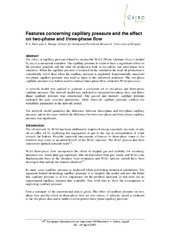| dc.contributor.author | Dale, Elisabeth Iren | eng |
| dc.contributor.author | Skauge, Arne | eng |
| dc.date.accessioned | 2011-12-07T12:41:06Z | |
| dc.date.available | 2011-12-07T12:41:06Z | |
| dc.date.issued | 2008-04-30 | eng |
| dc.identifier.isbn | 9789073781436 | en_US |
| dc.identifier.uri | https://hdl.handle.net/1956/5263 | |
| dc.description | 14th European Symposium on Improved Oil Recovery, Cairo, Egypt, 22. – 24. April 2007 | en |
| dc.description.abstract | The effect of capillary pressure related to immiscible WAG (Water Alternate Gas) is studied by use of a numerical simulator. The capillary pressure is found to have a significant effect on the pressure gradient and the total oil production both in two-phase and three-phase flow situations. When the capillary pressure is included in the simulation the total oil production is considerably lower than when the capillary pressure is neglected. Experimentally measured two-phase capillary pressure was used as input to the numerical simulator. The two-phase capillary pressure was further used to estimate three-phase flow, related to WAG processes. A network model was applied to generate a consistent set of two-phase and three-phase capillary pressure. The network model was anchored to measured two-phase data, and threephase capillary pressure was constructed. The gas-oil and mercury capillary pressure anchored the pore structure parameters, while water-oil capillary pressure anchors the wettability parameters in the network model. The network model quantifies the difference between three-phase and two-phase capillary pressure, and in the cases studied the difference between two-phase and three-phase capillary pressure was significant. | en_US |
| dc.language.iso | eng | eng |
| dc.publisher | EAGE | en_US |
| dc.relation.ispartof | <a href="http://hdl.handle.net/1956/5267" target="blank">Modelling of immiscible WAG with emphasis on the effect of capillary pressure</a> | en_US |
| dc.title | Features concerning capillary pressure and the effect on two-phase and three-phase flow | en_US |
| dc.type | Chapter | |
| dc.description.version | publishedVersion | en_US |
| dc.rights.holder | Copyright the authors. All rights reserved | en_US |
| dc.subject.nsi | VDP::Technology: 500::Rock and petroleum disciplines: 510::Petroleum engineering: 512 | en_US |
| dc.identifier.citation | In: Proceedings : 14th European Symposium on Improved Oil Recovery | |
